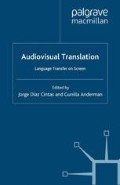Abstract
Screen translations, and especially those for the small screen, are consumed by millions of people in Europe, and of course all over the non-English speaking world, at every moment of the day.1 In this respect, Italy is representative of the many nations which require evergrowing amounts of interlingual mediation for both big and small screen. As is well known, Italy is commonly labelled a ‘dubbing country’ which, together with Austria, France, Germany and Spain, has adopted a tradition of dubbing rather than subtitling, the preferred mode of screen translation in Greece, Portugal, Scandinavia and the UK. However, the situation in dubbing countries is rapidly changing as a choice between dubbing and subtitling is now available on satellite stations and, owing to the fact that subtitling is the more cost-effective choice of the two, for the colossal DVD market.2 However, despite the fact that many younger people who are more proficient in English than their parents may well prefer subtitling to be more widely available, dubbing is bound to remain the chief form of linguistic mediation for some years. Perhaps it is worthwhile remembering that attitudes and preferences are largely an issue of habit and thus a person who has been used to almost a lifetime of dubbing is unlikely to be persuaded to change to a different mode of screen translation: ‘viewers are creatures of habit’ (Ivarsson, 1992: 66) and preferences depend on ‘what the audience is used to rather than rational arguments’ (ibid.: 20).
Access this chapter
Tax calculation will be finalised at checkout
Purchases are for personal use only
Preview
Unable to display preview. Download preview PDF.
References
Alfieri, G. (1994) ‘Lingua di consumo e lingua di riuso’. In L. Seriani and P. Trifone (eds) Storia della lingua italiana. Vol. II, Scritto e parlato (pp. 161–235). Torino: Einaudi.
Antonini, R., Bucaria, C. and Senzani, A. (2003) ‘It’s a priest thing, you wouldn’t understand: Father Ted goes to Italy’. Antares VI: 26–30.
Baccolini, R., Bollettieri Bosinelli, R.M. and Gavioli, L. (eds) (1994) Il doppiaggio. Trasposizioni linguistiche e culturali. Bologna: CLUEB.
Benincà, S. (1999) ‘Il doppiaggio: uno studio quali-quantitativo’. Quaderni del Doppiaggio II (pp. 53–148). Finale Ligure: Comune di Finale Ligure.
Bollettieri Bosinelli, R.M., Heiss, C., Soffritti, M. and Bernardini, S. (eds) (2000) La traduzione multimediale. Quale traduzione per quale testo? Bologna: CLUEB.
D’Amico, M. (1996) ‘Dacci un taglio, bastardo! Il doppiaggio dei film in Italia’. In E. Di Fortunato and M. Paolinelli (eds) Barriere linguistiche e circolazione delle opere audiovisive: la questione doppiaggio (pp. 209–16). Roma: AIDAC.
Fuentes Luque, A. (2001) ‘Estudio empírico sobre la recepción del humor audiovisual’. In L. Lorenzo García and A.M. Pereira Rodríguez (eds) Traducción subordinada (II). El subtitulado (pp. 85–110). Vigo: Universidade de Vigo.
Gallozzi, G. (2004) ‘Il silenzio dei doppiatori’. L’Unità, 18th February.
Gambier, Y. (ed.) (1998) Translating for the Media. Papers from the international conference ‘Languages and the Media’. Turku: University of Turku.
Gambier, Y. and Gottlieb, H. (eds) (2001) (Multi)Media Translation. Amsterdam and Philadelphia: John Benjamins.
Heiss, C. and Bollettieri Bosinelli, R.M. (eds) (1996) La traduzione multimediale per il cinema, la televisione e la scena. Bologna: CLUEB.
Ivarsson, J. (1992) Subtitling for the Media. Stockholm: TransEdit.
Karamitroglou, F. (2000) Towards a Methodology for the Investigation of Norms in Audiovisual Translation. Amsterdam: Rodopi.
Pavesi, M. (1994) ‘Osservazioni sulla (socio)linguistica del doppiaggio’. In R. Baccolini, R.M. Bollettieri Bosinelli and L. Gavioli (eds) Il doppiaggio. Trasposizioni linguistiche e culturali (pp. 51–60). Bologna: CLUEB.
Pavesi, M. (1996) ‘L’allocuzione nel doppiaggio dall’inglese all’italiano’. In C. Heiss and R.M. Bollettieri Bosinelli (eds) La traduzione multimediale per il cinema, la televisione e la scena (pp. 117–30). Bologna: CLUEB.
Pavesi, M. and Malinverno, A.L. (2000) ‘Usi del turpiloquio nella traduzione filmica’. In C. Taylor (ed.) Tradurre il cinema (pp. 75–90). Trieste: University of Trieste.
Editor information
Editors and Affiliations
Copyright information
© 2009 Rachele Antonini and Delia Chiaro
About this chapter
Cite this chapter
Antonini, R., Chiaro, D. (2009). The Perception of Dubbing by Italian Audiences. In: Cintas, J.D., Anderman, G. (eds) Audiovisual Translation. Palgrave Macmillan, London. https://doi.org/10.1057/9780230234581_8
Download citation
DOI: https://doi.org/10.1057/9780230234581_8
Publisher Name: Palgrave Macmillan, London
Print ISBN: 978-1-349-28600-3
Online ISBN: 978-0-230-23458-1
eBook Packages: Palgrave Language & Linguistics CollectionEducation (R0)

